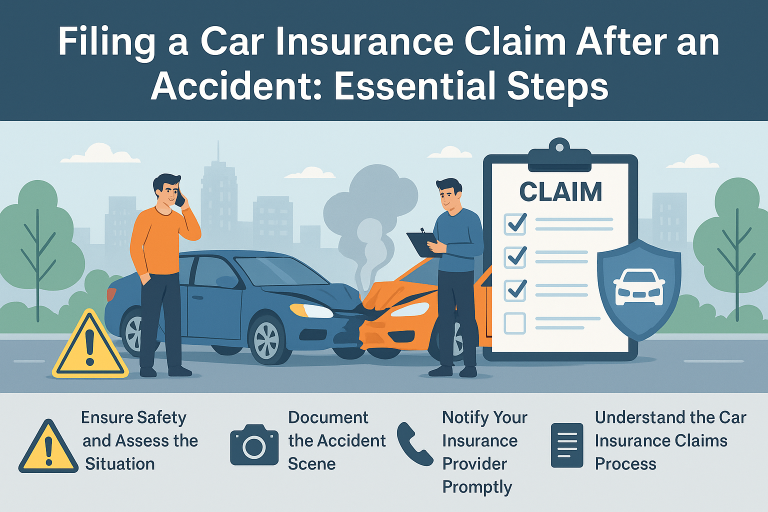Accidents are an unfortunate part of driving, but knowing how to file a car insurance claim can make the process significantly less stressful. Whether it’s a minor scrape or a major collision, taking the right steps ensures you receive the compensation you’re entitled to—without unnecessary delays or complications.
In this article, we’ll walk through the essential steps for filing a car insurance claim effectively, and explain how vehicle finance agreements—such as those with Motonovo, Black Horse Finance or other lenders—may influence parts of the process if your car is under finance.
Ensure Safety and Assess the Situation
Immediately after an accident, your first priority is safety. Check yourself, your passengers, and anyone else involved for injuries. If necessary, call emergency services.
If the vehicles are operable and it’s safe to do so, move them to the side of the road to avoid further danger. Even in seemingly minor incidents, staying calm and ensuring everyone is safe is the first step in managing the situation responsibly.
Document the Accident Scene
Thorough documentation is key to supporting your claim. Make sure to:
- Take clear photos of the scene, including vehicle damage, skid marks, road conditions, signage, and weather
- Capture images from multiple angles
- Record the time and location
- Gather the names, contact details, and insurance information of everyone involved
- Speak to witnesses and collect their statements and contact details
If the police attend the scene, request a copy of the report or at least the report number. This can be a crucial part of your claim file.
Notify Your Insurance Provider Promptly
Once everyone is safe and you’ve gathered your documentation, contact your insurance company to report the accident. Most insurers offer 24/7 claims lines, mobile apps, or online claim portals.
Provide them with:
- A detailed account of the accident
- Photos and supporting documents
- Contact and insurance information of other parties involved
- Any police or incident report details
Prompt reporting can help avoid delays and gives your insurer time to begin their assessment.
Understand the Car Insurance Claims Process
After filing, your insurer will begin investigating the claim. Depending on your coverage type—comprehensive, collision, or third-party—your insurer will determine liability, assess damage, and coordinate next steps.
If you’re not at fault, the other party’s insurer may cover your costs. If you are at fault, your own policy may be used to pay for repairs or a replacement vehicle, subject to your deductible.
Being honest and accurate in your report is essential to ensure a smooth process and avoid delays or disputes.
What If Your Car Is Financed Through Black Horse Finance or Another Lender?
If your vehicle is still under a Personal Contract Purchase (PCP) or finance agreement with Black Horse Finance or a similar lender, you’ll need to inform them if the car is significantly damaged or written off. In these cases:
- The insurance payout will often go directly to Black Horse Finance, since they are technically the legal owner of the vehicle until your final payment is made
- If the payout covers the remaining balance, the agreement is settled and any surplus may be returned to you
- If the payout is less than the outstanding loan, you may be required to pay the shortfall yourself
This is where GAP insurance can help. It covers the difference between the insurer’s settlement (based on market value) and the amount remaining on your finance agreement. Without it, you may be responsible for the balance out of pocket.
While this isn’t part of the insurance claim itself, it’s an important financial consideration for any driver with a PCP or hire purchase agreement.
Stay in Contact and Follow Up
Once your claim is filed, the process may take some time, especially in complex cases or where there is a dispute over fault. Keep in regular contact with:
- Your insurance claims handler to track progress and ensure no information is missing
- Your repair shop or assessor to understand the timeline and costs involved
- Your finance provider, if the car is written off, to ensure your agreement is properly settled
Stay organised by saving all communication, documentation, and receipts in a dedicated folder or digital record.
Repairing or Replacing Your Vehicle
If the damage is repairable, your insurer may send you to an approved repairer or allow you to choose your own. They may also provide a courtesy car while repairs are carried out.
If the vehicle is a total loss, your insurer will issue a payout based on the car’s market value at the time of the accident. If you’re financing the vehicle through Black Horse Finance, they will work with the insurer to settle your agreement. Be sure to confirm that all finance obligations have been addressed and keep records for your peace of mind.
Conclusion
Filing a car insurance claim after an accident doesn’t have to be overwhelming. By taking the right steps—ensuring safety, collecting accurate information, notifying your insurer promptly, and staying engaged—you can help ensure a faster, fairer outcome.
If your car is financed through a provider like Black Horse Finance, remember that your insurer will likely coordinate with them directly, especially in cases of total loss. You should still notify the finance company of the accident and confirm how your agreement will be settled.
Finally, consider GAP insurance to protect yourself from unexpected financial shortfalls. And if you believe your car finance agreement was mis-sold—for example, if fees were unclear or affordability wasn’t properly assessed—you may be eligible for a Black Horse Finance claim or a similar car finance mis-selling claim. This is a separate financial issue and would be handled independently from your insurer.
With the right information and a clear understanding of your obligations, you’ll be better equipped to manage your insurance claim and move forward with confidence.


